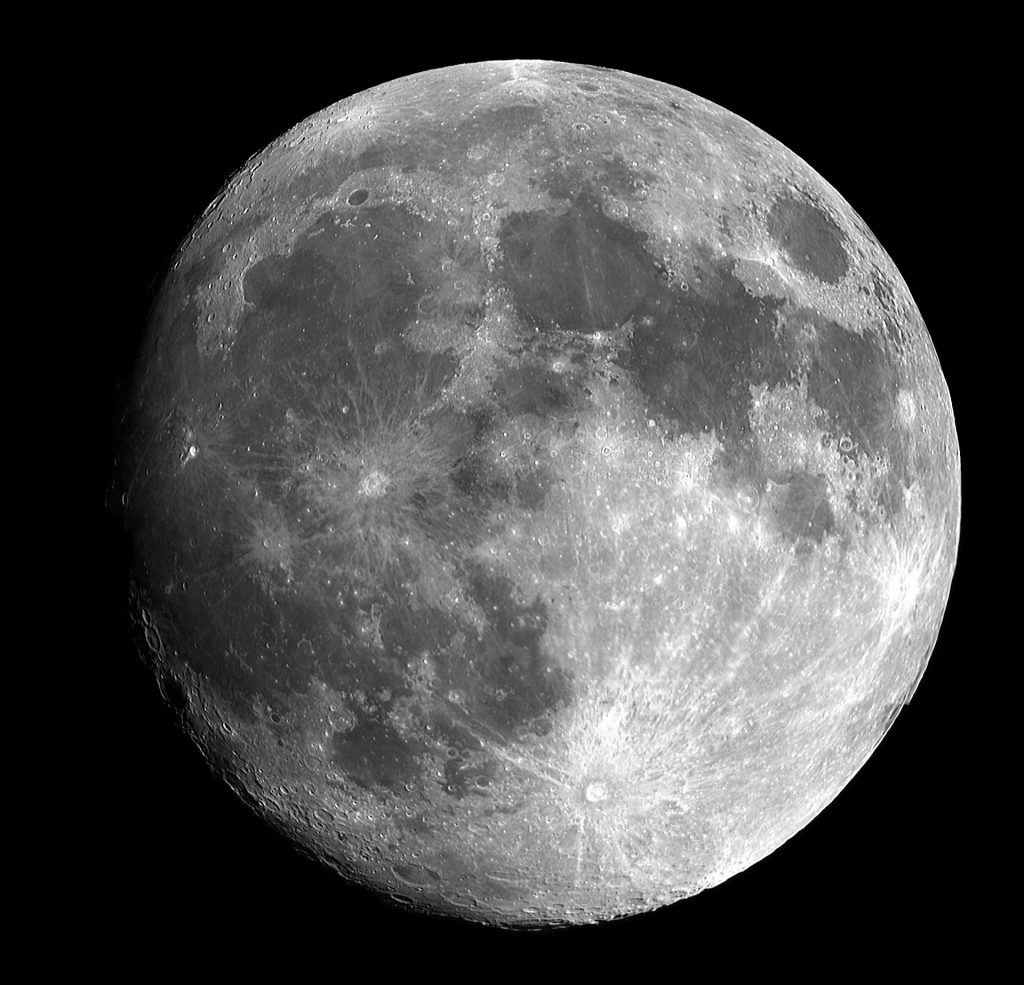This blog post was written by Jessica Hepner, an undergraduate in our Wildlife and Fisheries Science program, who was awarded a summer research grant by the College of Agricultural Sciences to analyze deer location data from The Deer-Forest Study. You will be reading more about her research in future articles as she also tackles how deer respond to wind and rain.
My grandfather has always been an avid hunter and strongly believes that deer are much more active with a full moon. It’s always been a thought provoking topic for me and it seems that everyone is interested in the effect that the moon has on deer.
Many people, including my grandfather, agree that the moon phase should influence white tailed deer activity patterns. In a survey of readers of this blog [you can take the survey here], more than half of readers believe that moon phase has some effect on deer.
Twenty two percent of readers believe that moon phase has a significant effect and the remaining 12% of readers believe the moon phase has absolutely no effect on deer.
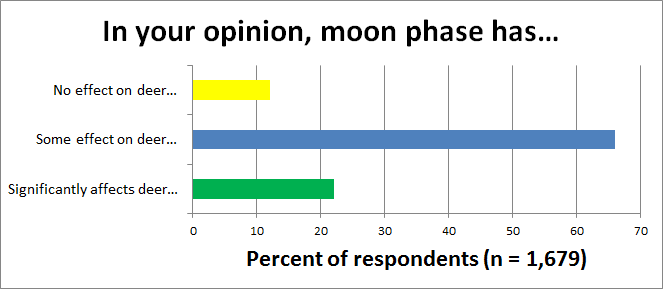
Also, we asked readers if they thought that the full moon would cause deer movements to increase during the night and decrease during the day. About 14% of readers strongly agree and about 44% agree that the full moon will affect deer movements in this way.
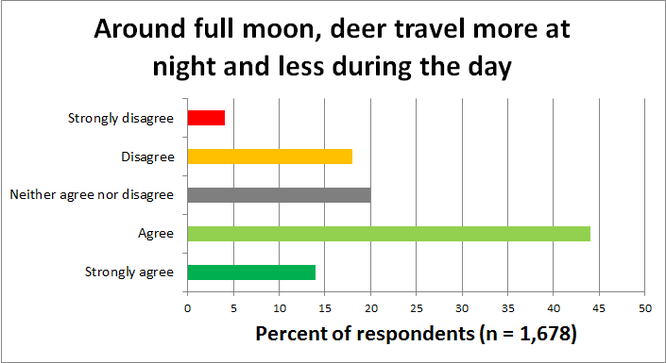
Activity of white-tailed deer has been found to vary with season, environmental factors, habitat, and hunting pressure. The graph below shows the average distance in meters per hour that deer are moving, for the month of October, over the 24-hour period.
On average, they move about 60 m/hr at night and less than 50 m/hr during the day. They are moving anywhere from 120 to 140 m/hr at dusk and dawn and are more active near sunset than sunrise. It is well known that peak activity for deer is around sunrise and sunset but moon phase has been proposed to influence and possibly interrupt that behavior pattern.
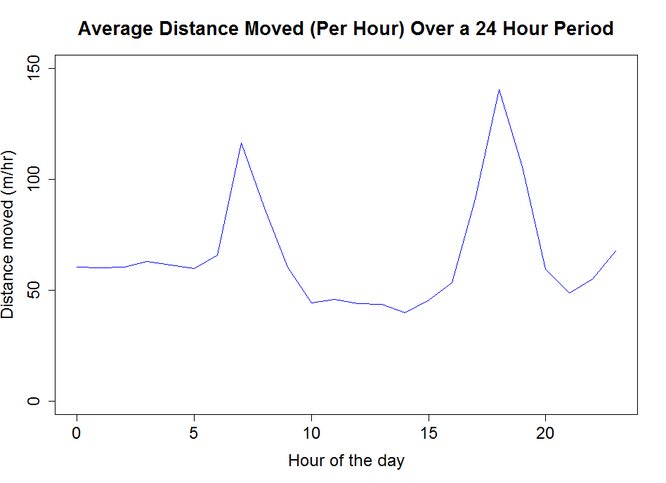
As I began my analysis, my opinion was that deer activity would increase around the time of the full moon, mostly just because that is what my grandfather was always telling me. The findings of previous research are mixed. Some studies of deer activity and moon phase have discovered a relationship whereas others have not. However, many of these studies were done before GPS collars were available.
White-tailed deer are crepuscular, meaning that they are most active around sunrise and sunset. Could this mean that moonrise and moonset might affect activity? Moonlight has been found to increase the risk of predation for some species, such as snowshoe hare that move less on moonlit nights, so deer movement could be related to moon phase and position.
To solve this mystery, I used location data from adult (>2 years old) deer fitted with GPS satellite collars for The Deer-Forest Study on the Susquehannock, Bald Eagle, and Rothrock state forests. I used data from October 2015 and October 2016.
For my analysis, I used location data for females only. I know you are asking, “Why not study the bucks?” Well, I chose to study does because locations for these females have been collected hourly, which provides much more data and more accurate results.
My statistical model used 3 variables (sunrise/sunset, moon phase, and hour of day) to predict movements. We categorized the moon phases into 3 different levels of illumination.
- Full – greater than 67% illuminated
- Partial – between 33 and 67% illuminated
- New – less than 33% illuminated
As we already knew, our results showed that deer activity is influenced by sunrise, sunset, and the time of day. Activity was greater at night than during the day and was highest within 2 hours of sunrise or sunset.
But what is the answer to the question we have all been waiting for? Does moon phase influence deer movement and what kind of effect does it have?
Results of our statistical analysis revealed that the 12% of readers who believed that moon phase would have no effect on deer at all were correct!
Moon phase has an insignificant effect on deer movement meaning that none of the moon phases cause deer activity patterns to increase or decrease significantly.
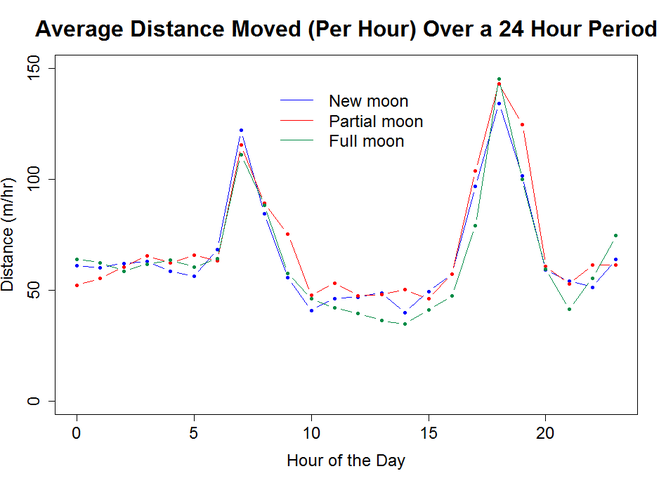
The graph below shows the average distance moved per hour over a 24-hour period during each of the three moon phases we have described.
Deer activity does vary ever so slightly throughout the lunar cycle and the model indicates that, on average, deer are moving about 6 meters more per hour when there is a new moon verses a full moon. When the moon is partial, deer move about 4 meters per hour more during the day than when it is a full moon.
However, these small differences are not statistically or biologically significant because deer can travel hundreds of meters in any given hour of the day. For example, our deer movement data ranges from 0 to 2,748 meters per hour.
That extra 4 to 6 meters (13 to 20 feet) is merely a few steps, like walking over to a new oak tree to snack on the more desirable acorns. For us it would be like taking an extra bathroom break during the day. You get the point, it means little to nothing about overall activity for the day or even the hour.
I must say it was very interesting to find out that contrary to popular belief, white tailed deer activity is not significantly affected by moon phase. Turns out that tracking the full moon to decide when to hunt may not be the best idea. I sure stumped my grandfather with this one!
-Jessica Hepner
Undergraduate in Wildlife and Fisheries Science
If you would like to receive email alerts of new blog posts, subscribe here.
And Follow us on Twitter @WTDresearch
